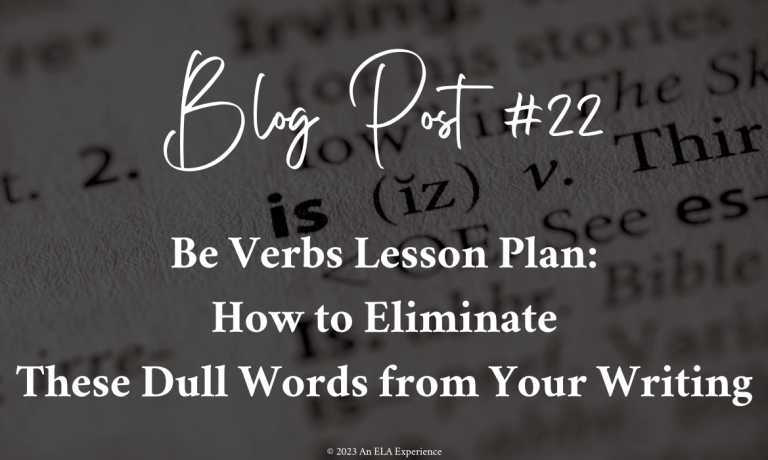If you’re ready to help your students take their writing to the next level, then look no further than this be verbs lesson plan! By learning how to reduce these humdrum verbs, students can make their writing more dynamic and engaging!
Teach the Be Verbs
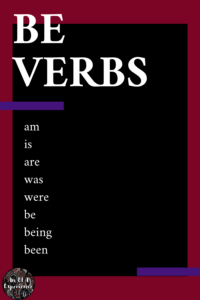
To reduce be verbs in their writing, students first need to recognize them, and this goal can be accomplished with chanting and reference materials.
- Whenever you’re studying be verbs, chant them with your students (am, is, are, was, were, be, being, been).
- Provide students with lists of the be verbs for their writers’ notebooks.
- Hang be verb anchor charts.
Play a Game of Simon Says During This Be Verb Lesson
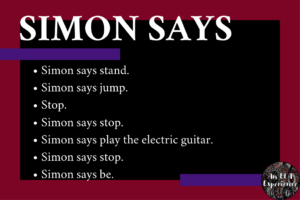
Be verbs are often necessary for constructing sentences, but overusing them can make writing dull and uninteresting. To make this point clear, play a quick game of Simon Says.
Say the following, for example:
- Simon says stand.
- Simon says jump.
- Stop.
- Simon says stop.
- Simon says play the electric guitar.
- Simon says stop.
- Simon says be (or am, is, are, was, were, being, been).
Students won’t know what to do when you use a be verb instead of a regular verb. You’ll also notice that when you say, “Simon says be,” some kids will buzz like a bee (again showing that be verbs aren’t like your average verb).
Explain to them that be verbs are verbs, but they do not show action. Instead, they show existence. When writing, they want to reduce them, but they do not want to eliminate all of them. Ask students to eliminate fifty percent of them. Also instruct them to keep them in dialogue because this sounds natural and keep them if the change would alter the meaning of the sentence. The goal is to make the writing better.
Teach Strategies to Reduce Be Verbs
Here are five ways to eliminate be verbs. For this be verb lesson, review these strategies with students and provide them with handouts for easy reference.
Substitute
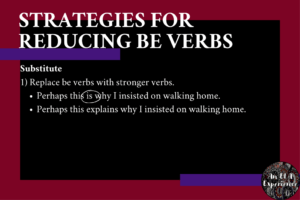
1) Replace be verbs with stronger verbs.
- Perhaps this is why I insisted on walking home.
- Perhaps this explains why I insisted on walking home.
Add
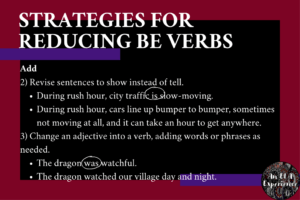
2) Revise sentences to show instead of tell.
- During rush hour, city traffic is slow-moving.
- During rush hour, cars line up bumper to bumper, sometimes not moving at all, and it can take an hour to get anywhere.
3) Change an adjective into a verb, adding words or phrases as needed.
- The dragon was watchful.
- The dragon watched our village day and night.
Combine

4) Combine sentences to include an appositive phrase.
- Emma is a college student. She waitresses at night.
- Emma, a college student, waitresses at night.
5) Move an adjective that follows a be verb to the front of the noun it’s describing and combine this with the sentence that follows.
- The salesman was charming. He knew exactly what to say.
- The charming salesman knew exactly what to say.
Model and Practice Reducing Be Verbs
Take out a piece of writing you’re working on, and circle every be verb with a colored pencil.
Count the be verbs used and make it your goal to eliminate fifty percent of them. Refer to your strategies for assistance, and have your students help you revise sentences that include be verbs. You’ll be surprised how well they do with this! Model the process with a few sentences, and then have them do the same with their own papers.
Revisit Be Verbs During the School Year
Now, during the school year, whenever it’s time to revise papers students are working on, give them class time to work on their be verbs.
Related Links
For more revising lessons, visit blog posts six and seven, “5 Proven Methods for Developing Ideas in Writing” and “Fun Activities for Synonyms to Inspire Students.”
To provide students with some practice with reducing be verbs using the strategies discussed, visit Worksheets on Be Verbs.
For more detailed information on eliminating be verbs in writing, visit “How to Eliminate ‘To Be’ Verbs in Writing.”
Be Verbs Lesson Plan in a Nutshell

- Chant the be verbs with students.
- Provide students with lists and strategies.
- Host a game of Simon Says with be verbs.
- Model the strategies for reducing be verbs.
- Have students apply what they learned to their own writings when they’re revising.
Feel free to leave comments with your students’ before and after sentences or to let me know if you have any strategies to add to this be verbs lesson plan!

